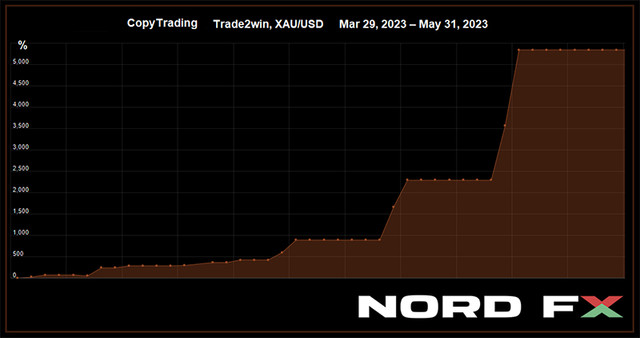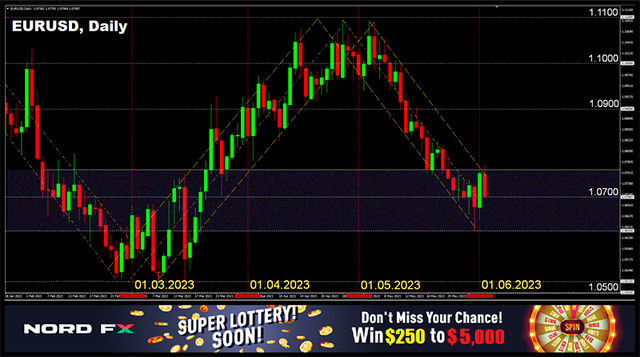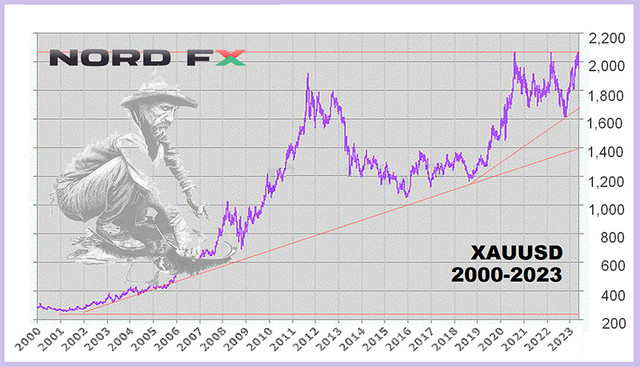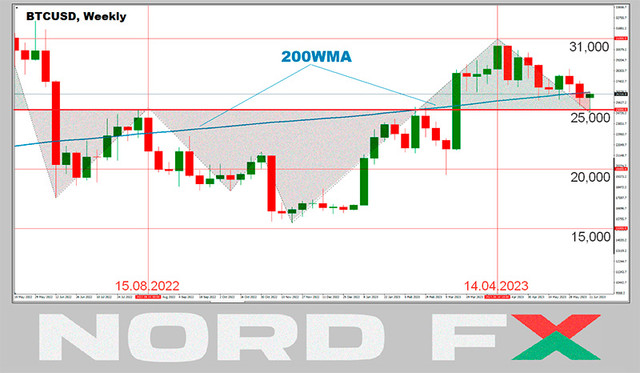Stan NordFX
NordFX Representative
- Messages
- 719
Forex and Cryptocurrency Forecast for May 29 – June 2, 2023
EUR/USD: Dollar Awaits U.S. Bankruptcy
The dollar has been rising since May 4. Last week, on May 26, the DXY Index reached 104.34. It hasn't been this high since mid-March 2023. What is driving the U.S. currency up and, consequently, pushing the EUR/USD pair down? According to analysts at Commerzbank, "the absolute calmness in the options market suggests that the driving force behind the EUR/USD exchange rate is monetary policy considerations rather than ongoing U.S. debt ceiling negotiations." It is worth noting that the probability of a rate hike at the June 14 FOMC (Federal Open Market Committee) meeting increased throughout May. At the beginning of the month, the likelihood of a rate increase was close to 0%, but by the end of the month, it reached 50%. It turns out that the U.S. economy is holding up very well compared to other economies, and the deterioration in lending has not been as severe or rapid as initially feared.
Of course, 50% is far from 100%. Moreover, the FOMC published the minutes of its latest meeting on Wednesday, May 24, and the key phrase regarding the possibility of additional tightening of monetary policy was absent. The document also revealed divergent opinions among committee members regarding further rate hikes. However, despite this, the flight to safety in anticipation of a potential U.S. default continued to support the dollar.
The United States government has been living with a debt that has already exceeded $31 trillion. If Congress does not raise its permissible limit by June 1, the U.S. will declare default. Treasury Secretary Janet Yellen has already warned about this multiple times. However, the actual date of bankruptcy may vary slightly from the "X Day" on June 1. For example, Deutsche Bank points to the end of July, while Morgan Stanley mentions either June 7-14 or July 21-28, and Goldman Sachs even suggests the end of September.
The authors of the British publication The Economist are alarming readers, stating that U.S. bankruptcy will cause a collapse in global stock markets and sow panic in the global economy. According to the estimates of the White House Council of Economic Advisers, the securities market will plummet by 45% in the first months of the crisis. Moody's agency predicts a decline of about 20%, but unemployment will increase by 5%.
As for politicians, discussions about extending the debt ceiling continue. On Wednesday, May 24th, Kevin McCarthy, the Speaker of the United States House of Representatives, noted that there is still work to be done to reach an agreement. However, he added that the country will not declare default. President Joe Biden also expressed confidence in reaching a deal with Republicans. An agreement is in the interests of both parties, as next year is an election year in the United States.
David Malpass, the President of the World Bank, stated in an interview with CNN that he does not expect a default and explained that such situations occur every few years. (For reference, the U.S. debt ceiling has existed since 1917 and has been raised 78 times since 1960).
As mentioned earlier, statistics indicate that the U.S. economy is feeling relatively confident. The GDP estimate for Q1 was revised upward from 1.1% to 1.3%. At the same time, the number of initial unemployment claims, forecasted at 250K, actually decreased to 229K. Durable goods orders increased by 1.1%. This figure followed a growth of 3.3% in March and exceeded market expectations, which anticipated a 1.0% decrease. Finally, the April National Activity Index from the Chicago Fed rose from -0.37 to +0.07.
Investment bank Goldman Sachs predicts further strengthening of the dollar due to the lack of an attractive alternative among other currencies. According to the bank's experts, there is currently no serious contender for the reserve status of the dollar in the world, including the euro. Unlike the American economy, the Eurozone does not please investors. If the preliminary estimate of Germany's GDP for Q1 was -0.1%, the reality showed a decline to -0.3%. Additionally, the Purchasing Managers' Index (PMI) for Germany's manufacturing sector declined (42.9 compared to the previous value of 44.5 and a forecast of 45.0), as did the country's business climate index (IFO) (91.7 compared to the previous value of 93.4 and a forecast of 93.0).
Starting the week at 1.0805, on May 25, EUR/USD reached a local low of 1.0701, and by the end of the five-day workweek (Friday evening, May 26), it is trading around 1.0725. As for the near-term prospects, at the moment, the majority of analysts (55%) anticipate a correction to the upside. 20% expect further strengthening of the dollar, while the remaining 25% hold a neutral position. Among the indicators on the daily chart (D1), there is a significant advantage for the dollar: 100% of oscillators are coloured in red (although a third of them signal oversold conditions for the pair), and among the trend indicators, 85% favour the red side (15% are on the green side). The nearest support for the pair is located around 1.0680-1.0710, followed by zones and levels at 1.0620 and 1.0490-1.0525. Bulls will encounter resistance around 1.0800-1.0835, followed by 1.0865, 1.0895-1.0925, 1.0985, 1.1045, 1.1090-1.1110, 1.1230, 1.1280, and 1.1355-1.1390.
The upcoming week features several notable events. The US Consumer Confidence Index will be published on Tuesday, May 30. The following day will bring unemployment and Consumer Price Index (CPI) data, while on Thursday, Germany's Purchasing Managers' Index (PMI) for business activity will be released. On June 1st, the preliminary Consumer Price Index (CPI) for the Eurozone and the minutes of the European Central Bank's latest Monetary Policy Committee meeting will be published. Additionally, a significant number of US economic data will be released, including labour market data and the Institute for Supply Management's (ISM) PMI for the US manufacturing sector. As is customary, the first Friday of summer will see another round of US labour market statistics, including the unemployment rate and the number of non-farm payroll jobs created in the country. Traders should also note that Monday, May 29, is Memorial Day in the United States, and there will be no trading.
GBP/USD: One Step Forward, One Step Back
Indeed, GBP/USD has been moving with one step forward and one step back recently. Although it appears to be heading downwards, a closer look at the chart reveals that it ended the week on Friday, May 26, at the same level it had reached in April and a week ago. On one hand, the strengthening dollar is pushing the pair down. On the other hand, hopes that inflation will prompt the Bank of England (BoE) to continue raising interest rates prevent it from plummeting into the abyss.
Fresh consumer inflation (CPI) data in the UK turned out to be significantly higher than expected. The April release showed a rise in consumer prices by 1.2% compared to the previous month's 0.8%. The core CPI reached multi-year highs, reaching 6.8% YoY instead of the forecasted 6.2%. Although the annual inflation rate slowed from 10.1% to 8.7%, it still exceeded the projected 8.2%. While it is the lowest level in 13 months, it remains well above the target level.
In response to this data, Bank of England Monetary Policy Committee member Jonathan Haskel stated that he would not comment on market prices but could not rule out further rate hikes. Another important figure, Chancellor of the Exchequer Jeremy Hunt, also expressed support for tightening monetary policy, even if it harms the economy. In an interview with Sky News, he stated that "it's not a trade-off between tackling inflation and recession; ultimately, the only route to sustainable growth is reducing inflation." Many analysts believe that if the Bank of England indeed raises rates by another 1.0%, the UK economy will fall into a recession, putting significant pressure on the pound.
At the time of writing, GBP/USD is trading around 1.2350. The current analyst consensus is nearly neutral, with 40% bullish, 30% bearish, and another 30% refraining from commenting. Among the oscillators on the D1 timeframe, 100% recommend selling (20% indicate oversold conditions). Among the trend indicators, the ratio between red and green stands at 65% to 35%. In the event of a southward movement, the pair will encounter support levels and zones at 1.2300-1.2330, 1.2275, 1.2200, 1.2145, 1.2075-1.2085, 1.2000-1.2025, 1.1960, and 1.1900-1.1920. If the pair rises, it will face resistance levels at 1.2390, 1.2480, 1.2510, 1.2540, 1.2570, 1.2610-1.2635, 1.2675-1.2700, 1.2820, and 1.2940.
As for the upcoming events in the following week, traders can enjoy a day off on Monday, May 29, in both the UK and the US as it is a public holiday. However, Thursday, June 1, is worth noting as it will reveal the Manufacturing Purchasing Managers' Index (PMI) for the country's manufacturing sector.
USD/JPY: Yen Receives "Ticket to the Moon"
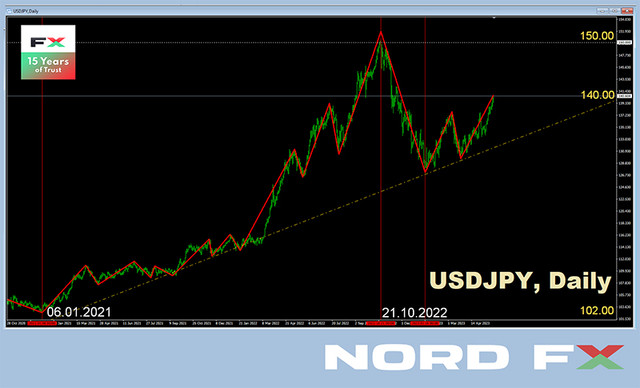
Вue to the ongoing ultra-accommodative policy of the Bank of Japan (BoJ) and similar statements from its new Governor Kadsuo Ueda, the yen was the weakest currency in the DXY basket in April. With a high probability, it will retain this title in May as well. Last week, USD/JPY continued its journey to the Moon. Starting at 137.93 on Monday, it reached above 140.70 on Friday evening, with a finish slightly lower in the 140.60 zone.
According to many analysts, the dovish stance of the Bank of Japan could continue undermining the Japanese currency and suggests that the path of least resistance for USD/JPY is upwards. This is supported by prospects of further interest rate hikes by the US dollar and new rising Treasury yields, increasing the interest rate differential between the US and Japan and encouraging a flow of funds from JPY to USD.
Regarding the near-term prospects of USD/JPY, analysts' opinions are divided as follows. Currently, 75% of them are hoping for at least a short-term strengthening of the Japanese currency and a correction to the south. Only 25% of experts vote for the continuation of the upward trajectory. Among the indicators on the daily chart, the US dollar has an absolute advantage, with 100% of trend indicators and 100% of oscillators pointing north (though 25% of the oscillators indicate overbought conditions for the pair). The nearest support level is located in the 139.85 zone, followed by levels and zones at 138.75-139.05, 137.50, 135.90-136.10, 134.85-135.15, 134.40, 133.60, 132.80-133.00, 132.00, 131.25, 130.50-130.60, and 129.65. The closest resistance is at 141.40, and then bulls will need to overcome obstacles at levels 142.20, 143.50, and 144.90-145.10. The October 2022 high of 151.95 is not far from there.
There is no significant economic information related to the Japanese economy expected for the upcoming week.
CRYPTOCURRIENCIES: Bitcoin Needs a Trigger
Bitcoin remains under pressure from sellers for the tenth consecutive week. However, despite the struggle, it manages to hold its ground in the strong support/resistance zone around $26,500. On Thursday, May 25, amid the strengthening of the dollar, bears launched another attack and pushed the BTC/USD pair down to the $25,860 level. A similar attack was observed on May 12 when the pair dropped to $25,799. But both attacks were repelled, and the storm did not occur.
Investors nostalgically recall the impressive start of the leading cryptocurrency in the first quarter of this year. However, since then, a period of calm and declining trading activity to three-year lows has set in. Some analysts believe that the current price fails to generate enthusiasm among both sellers and buyers. In this situation, investors are hesitant to spend money. According to the analytics agency Glassnode, long-term holders (over 155 days) have accumulated 14.5 million BTC coins. If we add the reserves of cryptocurrency exchanges and other aggregators to this figure, it will be even higher. Even short-term speculators have fallen into a state of hibernation. The market needs a trigger, which could be either decisions by the Federal Reserve regarding monetary policy or an announcement of a US government debt default.
There are two possible scenarios: either a default will be declared (which is unlikely), or it will not. In the first case, if a default occurs, investor confidence in the US dollar as a reserve currency will sharply decline, benefiting bitcoin as a safe haven asset. In the second case, if there is no default, it will become more challenging for cryptocurrencies. To replenish cash reserves, the US Treasury will issue a large number of bonds, causing their yields to rise, and investors will prefer to invest their money in these securities rather than BTC.
However, it is important to note that the announcement of a default could have a significant impact on the stablecoin market. It is worth remembering that Tether, the issuer of USDT, is one of the largest holders of US Treasury bills, surpassing countries like Thailand and Israel. The volume of these debt securities on Tether's balance sheet is $53 billion, or 64% of its own reserves. It is these reserves that support the liquidity of USDT. If a default occurs, then 1 stablecoin will be worth not $1 but only 36 cents. Alternatively, it is possible that it will simply cease to exist along with Tether.
Indeed, the situation is highly ambiguous. Furthermore, industry participants continue to be concerned about increasing regulatory pressure. It is worth noting that in 2023 alone, the US Securities and Exchange Commission (SEC) has filed complaints against cryptocurrency exchanges Bittrex, Coinbase, Kraken, Gemini, and Genesis. Additionally, the Commodity Futures Trading Commission (CFTC) has filed a lawsuit against Binance and its CEO, Changpeng Zhao. According to Yassine Elmandjra, an analyst at ARK Invest, this situation discourages new players and has a negative impact on existing companies, prompting them to flee from the United States to more crypto-friendly countries such as the UAE, South Korea, Australia, and Switzerland. (According to Coin Metrics, bitcoin trading volume in the US has declined by 75% over the past two months, from $20 million per day in March to $4 million in May).
Michael Saylor, the CEO of MicroStrategy, believes that active regulatory intervention will actually benefit bitcoin because it will create problems for its competitors. Saylor pointed out the increased investor interest shifting towards bitcoin from other tokens. According to him, BTC's competitors naturally fall away after more persistent regulation of the industry. This became particularly noticeable after SEC Chairman Gary Gensler stated that "all but bitcoin" fall under securities laws. Saylor believes that "crypto tokens and crypto securities will be regulated, and perhaps cease to exist. Bitcoin is the only commodity that the SEC is not going to regulate. Bitcoin is the safest network and the safest asset." He expects a continuous capital outflow from the rest of the crypto space into Bitcoin, and he already sees the beginning of a new bullish cycle. (As of April 4, 2023, MicroStrategy, along with its subsidiaries, held approximately 140,000 BTC, making it one of the largest holders of the cryptocurrency. The company paid a total of $4.17 billion for them. Thus, the average purchase price was $29,803 per bitcoin).
The opposite opinion is held by Bloomberg analyst Mike McGlone, who expects a collapse in the bitcoin price to the support level of $7,366. This forecast is based on the descending movement of the 52-week moving average (MA) on the BTC chart. McGlone notes that before the powerful pump in 2020, this line, on the contrary, was moving upwards. According to the expert, the negative trend will continue, and the cryptocurrency will face challenging times. (It should be noted that not long ago, at the end of last year, McGlone was looking in a completely different direction. At that time, according to his version, bitcoin was supposed to rise to $100,000).
In the absence of fundamental triggers, experts are paying more attention to technical analysis. For example, a trader known as Dave the Wave, who has made several accurate forecasts, believes that currently Bitcoin is consolidating in the "buying zone" of the logarithmic growth curve. This curve evaluates long-term highs and lows of the leading cryptocurrency throughout its lifecycle, ignoring short-term volatility. The analyst notes that based on the current market structure, a breakout signal from the consolidation channel would be a rise above $32,000. Therefore, according to Dave the Wave, any purchase below $31,000 is still considered an excellent deal. Based on his conservative estimate, the target price for bitcoin by the end of the year should be around $40,000.
Michael van de Poppe, an analyst, trader, and founder of the consulting platform EightGlobal, informed his Twitter followers that a successful retest of support at the $26,280 level (MA200) could mark the completion of the correction and consolidation for the leading cryptocurrency. Therefore, it is advisable to buy bitcoins at such a level. "If we look at past periods, the retest of the 200-day moving average has always been an excellent time to accumulate bitcoins. Over the past six months, Bitcoin has spent a long time below this indicator, making it [BTC] undervalued. The next week will be crucial - a quick retest and bounce upward will signify the end of the bitcoin correction," explains the crypto analyst. Michael van de Poppe is confident that for bitcoin to confirm future growth, it needs to firmly establish itself above $27,000.
The well-known saying goes, "Different people, different opinions." In this case, it can be paraphrased as "Different analysts, different forecasts." The opinions of representatives from the crypto community, surveyed by the online publication BeInCrypto, also turned out to be quite contradictory. For example, the forecast of popular blogger CryptoKaleo does not exclude the possibility of bitcoin reaching a new local high. Signals that indicate a bet on the coin's growth were also noticed by a trader known as DaanCrypto. He paid attention to the bounce of BTC from the weekly MA200 moving average. From a technical analysis perspective, such behavior of the cryptocurrency may indicate the strength of buyers.
On the other hand, crypto blogger Nebraskangooner sees signals for a decline on the chart. His forecast does not rule out a drop in the cryptocurrency to $25,500. According to the blogger, this is indicated by the coin's exit from the symmetrical triangle formation on the chart. The negative Bitcoin forecast was supported by the usually optimistic analyst Inmortal, who pointed to a target level of $22,000. However, Inmortal is confident that the cryptocurrency will be able to recover its position promptly.
As of the evening of Friday, May 26, BTC/USD is trading at $26,755. The total market capitalization of the crypto market stands at $1.123 trillion ($1.126 trillion a week ago). The Crypto Fear & Greed Index has remained relatively unchanged over the past seven days and is currently in the Neutral zone at a level of 49 (48 points a week ago).
NordFX Analytical Group
Notice: These materials are not investment recommendations or guidelines for working in financial markets and are intended for informational purposes only. Trading in financial markets is risky and can result in a complete loss of deposited funds.
#eurusd #gbpusd #usdjpy #btcusd #ethusd #ltcusd #xrpusd #forex #forex_example #signals #cryptocurrencies #bitcoin #stock_market
https://nordfx.com/


